New AMD Ryzen 3000XT Processors Available Today
by Dr. Ian Cutress on July 7, 2020 9:01 AM EST
Announced a couple of weeks ago, the new AMD Ryzen 3000XT models with increased clock frequencies should be available today in primary markets. These new processors offer slightly higher performance than their similarly named 3000X counterparts for the same price, with AMD claiming to be taking advantage of a minor update in process node technology in order to achieve slightly better clock frequencies.
The new 3000XT family of processors focuses mostly on boosting the turbo frequency by 100-200 MHz for the same power. AMD states that this is due to using an optimized 7nm manufacturing process. This is likely due to a minor BKM or PDK update that allows TSMC/AMD to tune the process for a better voltage/frequency curve and bin a single CPU slightly higher.
An update in this range could be indicative of a ~10 mV better voltage for a single core, although this would normally be in the binning noise - for it to be statistically relevant would need a lot of CPUs, so this could just be better binning. However, base frequencies haven’t moved much, so performance-per-watt benefits are going to be somewhat minimal. The biggest uptick would be in 1T scenarios.
Each of the new XT processors is the highest speed variant of its respective class.
| AMD 'Matisse' Ryzen 3000 Series CPUs | |||||||||
| AnandTech | Cores Threads |
Base Freq |
Boost Freq |
L3 Cache |
PCIe 4.0 |
TDP | Price (SEP) |
||
| Ryzen 9 | 3950X | 16C | 32T | 3.5 | 4.7 | 4x16 MB | 16+4+4 | 105W | $749 |
| Ryzen 9 | 3900XT | 12C | 24T | 3.8 | 4.7 | 4x16 MB | 16+4+4 | 105W | $499 |
| Ryzen 9 | 3900X | 12C | 24T | 3.8 | 4.6 | 4x16 MB | 16+4+4 | 105W | $499 |
| Ryzen 9 | 3900 | 12C | 24T | 3.1 | 4.3 | 4x16 MB | 16+4+4 | 65W | OEM |
| Ryzen 7 | 3800XT | 8C | 16T | 3.9 | 4.7 | 2x16 MB | 16+4+4 | 105W | $399 |
| Ryzen 7 | 3800X | 8C | 16T | 3.9 | 4.5 | 2x16 MB | 16+4+4 | 105W | $399 |
| Ryzen 7 | 3700X | 8C | 16T | 3.6 | 4.4 | 2x16 MB | 16+4+4 | 65W | $329 |
| Ryzen 5 | 3600XT | 6C | 12T | 3.8 | 4.5 | 2x16 MB | 16+4+4 | 95W | $249 |
| Ryzen 5 | 3600X | 6C | 12T | 3.8 | 4.4 | 2x16 MB | 16+4+4 | 95W | $249 |
| Ryzen 5 | 3600 | 6C | 12T | 3.6 | 4.2 | 2x16 MB | 16+4+4 | 65W | $199 |
| Ryzen 5 | 3500X | 6C | 6T | 3.6 | 4.1 | 2x16 MB | 16+4+4 | 65W | OEM |
| Ryzen 3 | 3300X | 4C | 8T | 3.8 | 4.3 | 1x16 MB | 16+4+4 | 65W | $120 |
| Ryzen 3 | 3100 | 4C | 8T | 3.6 | 3.9 | 2x8 MB | 16+4+4 | 65W | $99 |
Users should note that the prices listed are official SEP (Suggested Etailer Price). In March, AMD did announce a temporary AMD-focused price drop, but that has since passed. Retailer pricing will vary with local sales practices.
The top new processor is the Ryzen 9 3900XT which offers +100 MHz turbo over the 3900X, for the same official price as the 3900X. The 3800XT offers +200 MHz on single core turbo over the 3800X for the same price. The final new processor is the 3600XT, with +100 MHz on the turbo frequency, again for the same price over the 3600X.
In each three cases, the XT processors give slightly better frequency than the X units, so we should expect to see an official permanent price drop on the X processors in order to keep everything in line.
AMD’s announcement today also includes information about thermal solutions. The Ryzen 5 3600XT, with six cores, will come bundled with AMD’s Wraith Spire cooler. For the other two CPUs, AMD’s own press release states that the company ‘is recommending the use of an AIO solution with a minimum 280mm radiator or equivalent air cooling to experience these products at their best’. This does seem somewhat overkill for 105 W processors, especially if the package power tracking on these parts should be ~142 watts, notwithstanding any trickery that the motherboard manufacturers are doing.
These new processors will be supported in any motherboard that already supports Zen 2-based Ryzen 3000 hardware (the cost in BIOS space to add a CPU of the same family is negligible).
Performance
While we have had these three processors in for testing over the last week or so, we are in the process of transitioning to a new benchmark suite for 2020/2021, with updated CPU tests, newer games, and game testing with RTX 2080 Ti graphics cards. This bench suite is still a work in progress with regression testing older models, and so at this point we do not have a strong enough dataset to confidently do the processors a full review in the AnandTech way. A number of the tests use updated software packages, and so comparison to previous versions is not possible, however we do have some metrics which align that we can share with you.
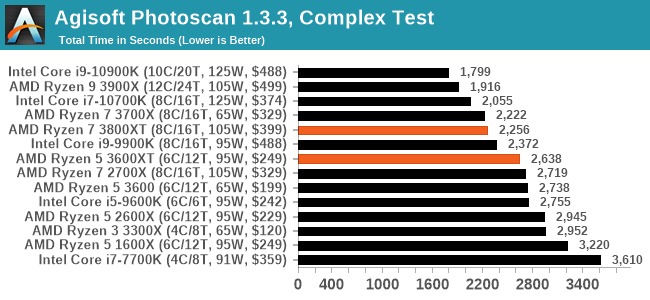
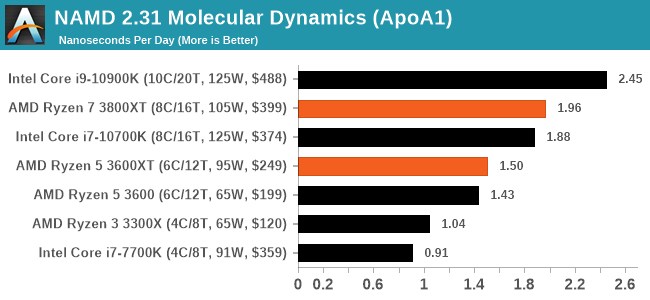

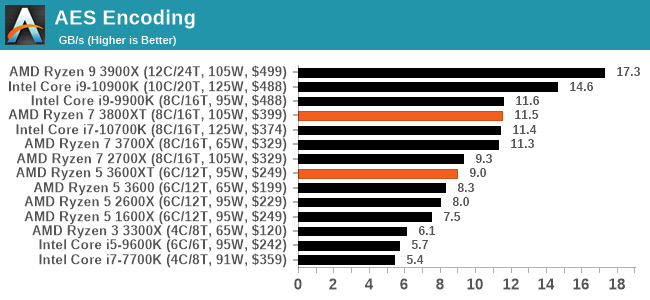
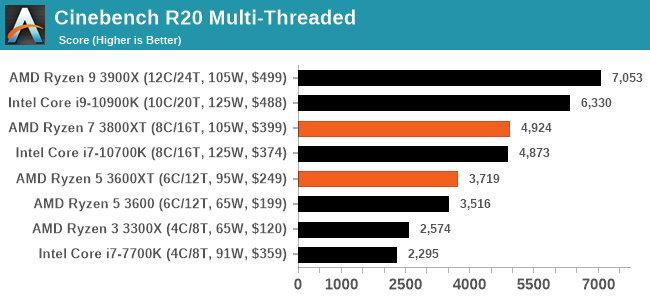
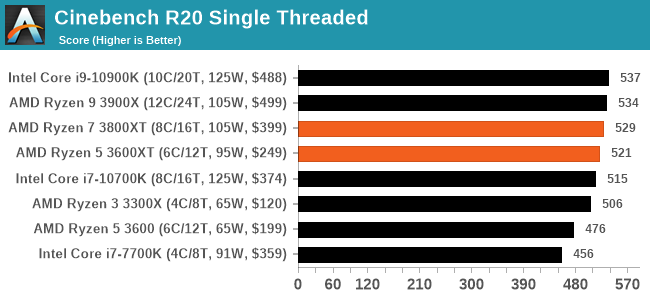
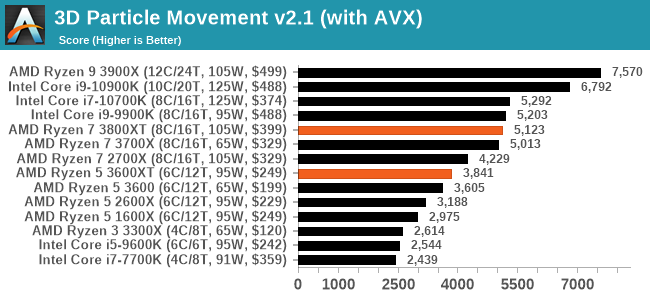
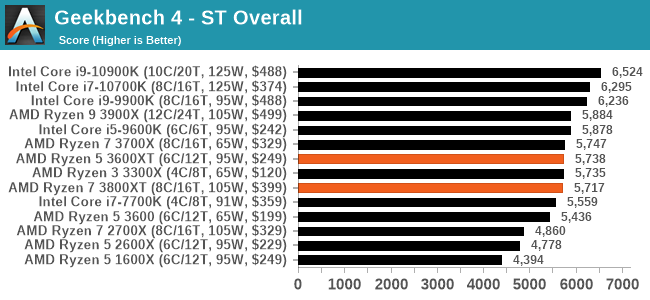
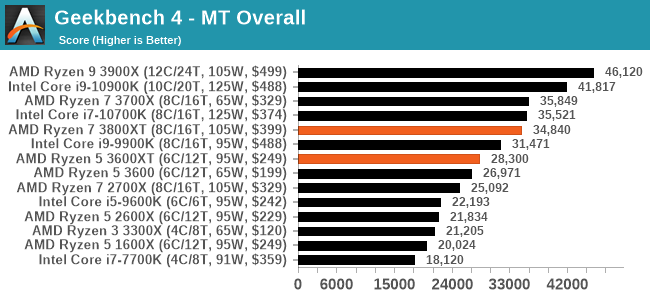
Graphs will be updated as results come in.
As we can see, there isn’t much between the old X models and the new XT models – increasing the turbo frequency a little means that there is scope for increased performance in low thread-count workloads, but ultimately the voltage/frequency curve when we start pushing with more cores loaded counts in those high density benchmarks.
We’re planning on doing a full article with our updated benchmark suite and new tests after we’ve done more regression testing. There will also be a new section in Bench to cover our new benchmark suite. Stay tuned for that.
Related Reading
- AMD To Launch New Ryzen 3000 XT CPUs: Zen 2 with More MHz
- Electromigration: Why AMD Ryzen Current Boosting Won't Kill Your CPU
- AMD Ryzen 5 3600 Review: Why Is This Amazon's Best Selling CPU?
- The AMD Ryzen 3 3300X and 3100 CPU Review: A Budget Gaming Bonanza
- AMD’s Mobile Revival: Redefining the Notebook Business with the Ryzen 9 4900HS (A Review)
- The Corsair Hydro X Custom Water Cooling Review, on a Ryzen 9 3950X
- The ASRock X570 Aqua: A $1000 Ryzen Halo Motherboard Reviewed
- The AMD Ryzen Threadripper 3960X and 3970X Review: 24 and 32 Cores on 7nm










111 Comments
View All Comments
lmcd - Thursday, July 9, 2020 - link
Why on earth would a static analysis reference a live price? A statement about value with a moving price is absolutely idiotic, and MSRP reflects the manufacturer's strategy in a way that's more interesting than retailers' strategy anyway. Obviously I wasn't going to buy an AMD card when those were the mining card of choice, but it was still interesting to note how close their MSRP/performance ratio was or wasn't.Anandtech also does regular roundups that would, if not for the wildly fluctuating prices, sate your very need.
Spunjji - Monday, July 13, 2020 - link
I don't come here to read about "manufacturer's strategy", and MSRP doesn't really reflect it anyway. Neither does current pricing necessarily only reflect an individual retailer's strategy.If all (or most) retailers are providing a price lower than MSRP, you can infer that the manufacturer has lowered the wholesale price. That's entirely separate from the sort of market distortions we saw with mining.
Zizy - Wednesday, July 8, 2020 - link
The cheapest one you can realistically buy the part for, what else?Spunjji - Wednesday, July 8, 2020 - link
You're making this argument as a defence of bad information. A person doesn't have to provide a workable alternative to observe that a methodology is bad, though this is a common misconception.alufan - Tuesday, July 7, 2020 - link
what I would like to see is instead of the pointless TDP figure as we know both sides manipulate these in some way can we have the actual TDP seen at the time of the test most testers have a basic test rig spec which can me referenced in the results as well, and yes real world prices please these are easy to find by linking the prices with the article use Amazon etc as a benchmarkSpunjji - Wednesday, July 8, 2020 - link
That would be neat, too. An average power draw for the test as performed rather than the useless manufacturer figure - that way a buyer knows the actual thermal load they'll need to dissipate.Lord of the Bored - Tuesday, July 7, 2020 - link
If I'm not mistaken, the prices listed are the manufacturer's suggested price. Since price-fixing is illegal, and CPU manufacturers haven't figured out how to make it happen without getting caught, real-world prices basically never align with suggested retail.JoeDuarte - Tuesday, July 7, 2020 - link
You might misunderstand what price fixing is. It's when competing vendors coordinate their prices together. That's usually illegal. Companies are free to dictate the prices that retailers charge for their products. That's not price fixing.qwertymac93 - Tuesday, July 7, 2020 - link
Price fixing is illegal; resale price maintenance isn't. Minimum advertised price policy and unilateral minimum price policies are legal and have been used or are in use by both AMD and Intel.cfenton - Tuesday, July 7, 2020 - link
Amazon and Newegg prices can change day to day. Clearly Amazon is out of 10900K stock and some marketplace seller is trying to rip someone off. MSRP is the only price that will have any consistency. The writers can't be expected to come back and update all of their charts whenever Newegg has a sale.It would also be difficult to account for all the different retailers. As you point out, they often have different prices for the same product. Is the street price what Newegg is charging, or is it what Microcenter is charging? I don't live anywhere near a Microcenter, but that price is available to some people.
To me, if you can get something for less than MSRP, great, you're getting a deal. If it's more, don't buy it. MSRP is useful as a guide for how much something should cost and it's up to you to determine if a retailer is currently offering a good price.